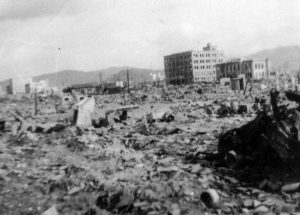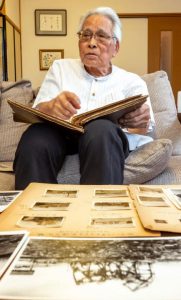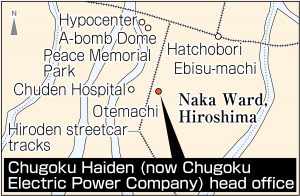Striving to fill voids in Hiroshima, evidence of victims remains—Mr. Hirahara (97), of Onomichi, explains 13 photos of ruins he took 4 months after A-bombing
Oct. 8, 2022
Traded sweet potatoes to obtain photographic film
by Kyosuke Mizukawa, Senior Staff Writer
One photographer who took photos when he was 20 of the devastation in the city of Hiroshima four months after the atomic bombing turned 97 this year. Tsutae Hirahara, a resident of Onomichi City, was an employee of Chugoku Haiden (now the Chugoku Electric Power Company) when he took the photos. “I managed to get my hands on photographic film by making a trade for my sweet potatoes,” he said. Amid the current situation in which people who photographed Hiroshima soon after the A-bombing who are still alive and well dwindle in number, Mr. Hirahara spoke in an interview about the circumstances of his photography work and emotional state at that time of supply shortages.
Mr. Hirahara has kept on hand at his home 13 print photos he took on December 11, 1945. The photos show the devastation caused to the Chugoku Haiden’s facilities, including the organization’s head office in the area of Komachi (now part of Hiroshima’s centrally located Naka Ward), which was incinerated by fire inside at a location about 700 meters from the hypocenter, as well as the surrounding area and the incinerated ruins of the city’s downtown area.
“There were almost no people in the city ruins and only a few buildings remained. As I snapped the shutter, I realized the gravity of the situation.” While looking at each photo at his home, he retraced his memories of that time.
Mr. Hirahara was born to a farming family in what is now the area of Kurihara-cho, Onomichi City, in 1925. In 1940, he started work at Hiroshima Electric, the predecessor organization to Chugoku Haiden, entering a technical training program at the head office through which young employees underwent training. He moved into a dormitory in the area of Otemachi (now part of the city’s Naka Ward), near the head office, where he spent two years in his late teens.
Shocked to hear of devastation
Looking back, he described Hiroshima as a big city. He would often go to see movies and visit music shops in the Hatchobori area (now part of the city’s Naka Ward), which was a bustling shopping district. He bought a camera around the age of 17 and took photos of his acquaintances in the dormitory.
Later, while working at Chugoku Haiden’s Onomichi office, he was drafted into the military and, in the spring of 1945, after receiving training at an aviation unit in Matsue City (in neighboring Shimane Prefecture), he was assigned to service in Kyushu. Returning to his unit in Matsue City after the war ended on August 15, he was shocked to hear of Hiroshima’s devastation. “When I asked a woman on the train who was in Hiroshima at the time about the situation in the city, she said it had been incinerated, and when I asked her about Chugoku Haiden, to my surprise she replied, ‘It’s probably gone.’”
Mr. Hirahara returned to his hometown on August 18 and rejoined the Onomichi office. Concerned about the situation in Hiroshima, he was determined to take photos of the city. However, the lack of supplies made it difficult to obtain photographic film. After learning that a worker in the office had film, he negotiated with the person and made a trade for sweet potatoes. “My parents were farmers, so I brought lots of sweet potatoes with me. Back then, potatoes were precious due to food shortages,” he explained.
On his visit to Hiroshima to take photos, he went to the burned ruins of the area around what is now Chuden Hospital, where his dormitory had stood prior to the A-bombing, and took photos of Chugoku Haiden’s Otemachi substation, whose walls were destroyed and steel frame was exposed. A total of 274 Chugoku Haiden employees died in the A-bombing. He also took photos of the devastation of the Hatchobori area, a place with which he was familiar before the bombing. Wreckage composed of such daily items as incinerated bicycles and melted liquor bottles is still branded in his memory.
Expectations for tragedy to be passed on
While Mr. Hirahara continues to hold on to the photos, he donated the negatives to the Hiroshima Peace Memorial Museum, located in the city’s Naka Ward, in 1985. Although he had not been well known as a photographer, a staff member at the museum described the photos as precious materials because “we are still able to consult with the very person who took them about the situation at the time.” The 13 photos can be accessed through the museum’s database posted on its website.
Amid an increased risk of the use of nuclear weapons with Russia’s invasion of Ukraine, Mr. Hirahara hopes that the tragedy of the A-bombing can be conveyed more widely to people through his A-bombing photos. “I took the photos out of personal interest in what Hiroshima was like at the time, but I would be moved if they were to prove useful now. In any case, I despise war,” said Mr. Hirahara.
Keywords
Photographers of Hiroshima’s A-bombing
In 2007, the Chugoku Shimbun examined all the photographs of Hiroshima that had been taken after the A-bombing by people on the Japanese side of things until the end of 1945. In the form of a list, the newspaper reported a list of the 57 photographers (including Mr. Hirahara) identified at that time. Last year, after examining the materials donated to the Peace Memorial Museum since 2007, the paper confirmed that four other people and one research team had also taken photos. Some people, like Mr. Hirahara and 94-year-old Seiso Yamada, who took photos of the mushroom cloud, are alive and well, but most of the people have died.
(Originally published on October 8, 2022)










